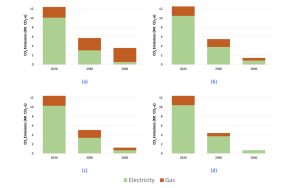Report: The future of hot water is electric
If you want to save money and help accelerate Australia’s path to net zero, switching from gas to electric-powered domestic hot water systems is a great idea.

Let’s start with a few “did you know” morsels.
- Domestic hot water accounts for about one quarter of energy use in the home;
- It is responsible for around one fifth of Australian residential greenhouse gas emissions;
- Natural gas powers more than 40 per cent of all domestic hot water systems in Australia.
- By 2030, domestic gas hot water systems will no longer have the lowest average running costs, they will be the most expensive;
- Renewable energy sources will drive down emissions from electric-powered systems but emissions from gas systems will not improve.
These are some of the findings of a University of Technology Sydney (UTS) Institute for Sustainable Futures (ISF) report, Domestic Hot Water and Flexibility.
From the point of view of household bills alone, the ARENA-commissioned report also found completely phasing out gas water heaters in homes would provide combined annual savings of $4.7–6.7 billion by 2040.

Flexible. (c) Highly Efficient. (d) Rapid Electrification (Source: UTS Domestic Hot-water and Flexibility report)
Under the same scenario, domestic hot water systems could slashed their emissions by more than 90 per cent.
By heating and storing hot water at times of the day when solar generation is at its peak, Australia’s collective domestic hot water systems could absorb 15 to 31 GWh of energy per day.
Not only would that be an effective use of solar energy when it is most abundant, it would also act as a massive source of flexible demand to help maintain the stability of electricity networks.
What are the alternatives to gas?
The report focuses on three types of domestic hot water systems: electric resistance; instantaneous gas; and air-source heat pump.
The first two are currently the most commonly installed in Australia. Heat pumps are relatively expensive to buy and install now, but are growing more popular because they are highly efficient systems and cheap to run.
Electric resistance water heaters are basically sophisticated electric kettles. They simply pass electricity through a heating element and then store the hot water in a tank for later use. They are cheap, simple and flexible. Where off-peak tariffs are available, they can take advantage of low-cost electricity.
Air-source heat pumps operate much like reverse-cycle air conditioners in winter. They extract heat from the air outside. But instead of warming a room, they heat water and store it in a tank. Heat pumps are much more efficient than resistance heaters, cheaper to run, but more expensive to buy and install.
What could the future look like?

Looking ahead, the report examined four scenarios;
Business as Usual – with no measures to phase out gas hot water systems.
Highly Flexible – assumes a gradual, but accelerating gas phase out and replacement, predominantly by electric resistance units.
Highly Efficient – assuming similar progress in phasing out gas but prioritising heat pump electric units.
Rapid Electrification – assumes no sales of gas domestic hot water systems after 2025 and 100 per cent take up of electric-powered domestic hot water systems by 2035.
Not surprisingly, the Rapid Electrification scenario produced the most dramatic reductions in emissions and running costs.
Business as Usual did reduce see reduced emissions thanks to more and more renewable electricity in the mix. But emissions from gas hot water systems increased.
Interestingly, the Highly Flexible scenario, which would maximise network operator opportunities to control demand, produced almost identical emissions and running cost reductions to the Highly Efficient approach.
In other words, measures to phase out gas water systems produce the sharpest reductions in emissions and running costs. And the quicker the better. But the choice of replacement electric technology is less important.
Factors that influence consumer choice would likely include awareness of the options, availability, suitability to location (geographical and housing type), and decisions about prioritising up-front costs versus lifetime running costs.
Unlocking the potential of domestic hot water systems
ARENA CEO Darren Miller said the report shows “the potential of domestic hot water systems across Australia to help reduce energy bills and lower emissions.”
“As households continue to purchase electric hot water systems, we can look to options to dynamically manage load, ensuring the benefits of renewables are realised at least cost to consumers.”
ISF Research Director David Roche says the report builds on knowledge that current electric water heating technologies can both save energy and provide significant demand flexibility.
“Our work shows that, with the right policy mix, domestic hot water alone can add over 30 GWh of energy storage to the National Electricity Market. That’s the equivalent of over 2 million home batteries,” he said.
“That would reduce consumers’ energy bills by over $6 billion per year while accelerating the path to net zero.”
LIKE THIS STORY? SIGN UP TO OUR NEWSLETTER

ARENA